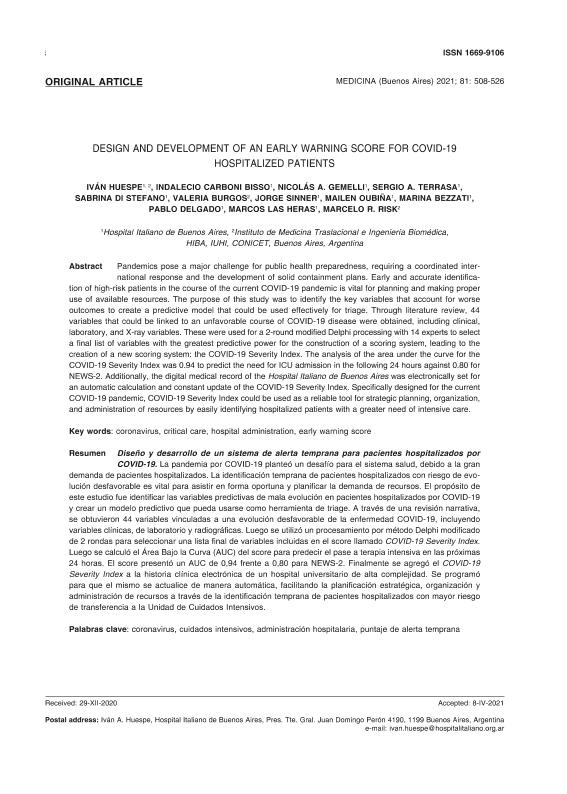Artículo
La pandemia por COVID-19 planteó un desafío para el sistema salud, debido a la gran demanda de pacientes hospitalizados. La identificación temprana de pacientes hospitalizados con riesgo de evolución desfavorable es vital para asistir en forma oportuna y planificar la demanda de recursos. El propósito de este estudio fue identificar las variables predictivas de mala evolución en pacientes hospitalizados por COVID-19 y crear un modelo predictivo que pueda usarse como herramienta de triage. A través de una revisión narrativa, se obtuvieron 44 variables vinculadas a una evolución desfavorable de la enfermedad COVID-19, incluyendo variables clínicas, de laboratorio y radiográficas. Luego se utilizó un procesamiento por método Delphi modificado de 2 rondas para seleccionar una lista final de variables incluidas en el score llamado COVID-19 Severity Index. Luego se calculó el Área Bajo la Curva (AUC) del score para predecir el pase a terapia intensiva en las próximas 24 horas. El score presentó un AUC de 0,94 frente a 0,80 para NEWS-2. Finalmente se agregó el COVID-19 Severity Index a la historia clínica electrónica de un hospital universitario de alta complejidad. Se programó para que el mismo se actualice de manera automática, facilitando la planificación estratégica, organización y administración de recursos a través de la identificación temprana de pacientes hospitalizados con mayor riesgo de transferencia a la Unidad de Cuidados Intensivos. Pandemics pose a major challenge for public health preparedness, requiring a coordinated international response and the development of solid containment plans. Early and accurate identifica tion of high-risk patients in the course of the current COVID-19 pandemic is vital for planning and making proper use of available resources. The purpose of this study was to identify the key variables that account for worse outcomes to create a predictive model that could be used effectively for triage. Through literature review, 44 variables that could be linked to an unfavorable course of COVID-19 disease were obtained, including clinical, laboratory, and X-ray variables. These were used for a 2-round modified Delphi processing with 14 experts to select a final list of variables with the greatest predictive power for the construction of a scoring system, leading to the creation of a new scoring system: the COVID-19 Severity Index. The analysis of the area under the curve for the COVID-19 Severity Index was 0.94 to predict the need for ICU admission in the following 24 hours against 0.80 for NEWS-2. Additionally, the digital medical record of the Hospital Italiano de Buenos Aires was electronically set for an automatic calculation and constant update of the COVID-19 Severity Index. Specifically designed for the current COVID-19 pandemic, COVID-19 Severity Index could be used as a reliable tool for strategic planning, organization, and administration of resources by easily identifying hospitalized patients with a greater need of intensive care.
Diseño y desarrollo de un sistema de alerta temprana para pacientes hospitalizados por COVID-19
Huespe, Ivan; Carboni Bisso, Indalecio; Gemelli, Nicolas A.; Terrasa, Sergio Adrian ; Di Stefano, Sabrina; Burgos, Valeria Laura
; Di Stefano, Sabrina; Burgos, Valeria Laura ; Sinner, Jorge; Oubiña, Mailen; Bezzati, Marina; Delgado, Pablo; Las Heras, Marcos; Risk, Marcelo
; Sinner, Jorge; Oubiña, Mailen; Bezzati, Marina; Delgado, Pablo; Las Heras, Marcos; Risk, Marcelo
 ; Di Stefano, Sabrina; Burgos, Valeria Laura
; Di Stefano, Sabrina; Burgos, Valeria Laura ; Sinner, Jorge; Oubiña, Mailen; Bezzati, Marina; Delgado, Pablo; Las Heras, Marcos; Risk, Marcelo
; Sinner, Jorge; Oubiña, Mailen; Bezzati, Marina; Delgado, Pablo; Las Heras, Marcos; Risk, Marcelo
Fecha de publicación:
08/2021
Editorial:
Medicina (Buenos Aires)
Revista:
Medicina (Buenos Aires)
ISSN:
0025-7680
Idioma:
Inglés
Tipo de recurso:
Artículo publicado
Clasificación temática:
Resumen
Archivos asociados
Licencia
Identificadores
Colecciones
Articulos (IMTIB)
Articulos de INSTITUTO DE MEDICINA TRASLACIONAL E INGENIERIA BIOMEDICA
Articulos de INSTITUTO DE MEDICINA TRASLACIONAL E INGENIERIA BIOMEDICA
Citación
Huespe, Ivan; Carboni Bisso, Indalecio; Gemelli, Nicolas A.; Terrasa, Sergio Adrian; Di Stefano, Sabrina; et al.; Diseño y desarrollo de un sistema de alerta temprana para pacientes hospitalizados por COVID-19; Medicina (Buenos Aires); Medicina (Buenos Aires); 81; 4; 8-2021; 1-19
Compartir



